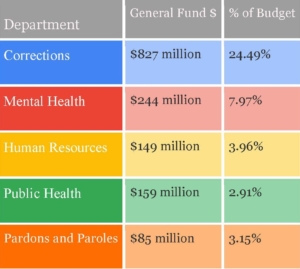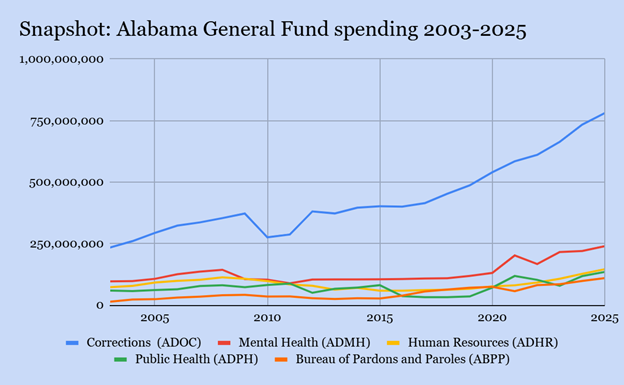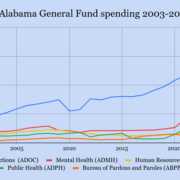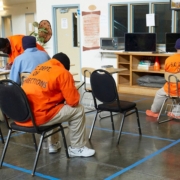As legislative budget hearings take place this week in Montgomery, it’s a good time to review the recent costs to Alabama taxpayers for our prison system, which consumes 25% of the state’s General Fund budget.
An Appleseed analysis has found that state prison expenses over five years are $5 billion. That’s right, if you include the annual General Fund allocations to the Alabama Department of Corrections, plus the costs of new prison construction including debt service, the people of Alabama will have handed over approximately $1 billion per year to ADOC in fiscal years 2022, 2023, 2024, 2025, and 2026.
Here’s the full breakdown based on publicly available spreadsheets from the Executive Budget Office:
- $610.7 million from the General Fund in FY2022
- $663.6 million from the General Fund in FY2023
- $733.7 million from the General Fund in FY2024
- $780.6 million from the General Fund in FY2025
- $826.7 million from the General Fund in FY2026 (which starts in October)
- $1.3 billion authorized for prison construction during 2021 special session on prisons, currently being used to build the Gov. Kay Ivey megaprison in Elmore County, which is expected to cost $1.2 billion.
- $85 million from the General Fund in FY25 and FY26 for debt service on prison construction bonds issued to build the 4000-bed prison in Elmore County.
By way of comparison, each bed in the Governor Kay Ivey megaprison, comes at a cost of $300,000, significantly more than the average price of a home in Alabama, which was $235,066 as of July of 2025.
This $5 billion tally does not include at least $57 million paid out of the state’s General Liability Trust Fund in recent years on ADOC legal expenses, primarily private contract attorneys to defend officers accused of misconduct and to defend the ADOC in federal class action litigation over unconstitutional prison conditions.
ADOC is the second highest General Fund expense in the State. Medicaid is the highest. Medicaid provides healthcare to approximately one million Alabamians at a similar cost to the state for incarceration of approximately 22,000 individuals in custody, plus another 4,300 in Community Corrections.
Last session, lawmakers passed a bill to add another $500 million to the state’s bonding capacity to pay for more prison space, a second planned megaprison in Escambia County.
Appleseed believes Alabamians deserve to know the significant costs to our state of consistently having one of the country’s highest incarceration rates. Alabama is a poor state when compared to numerous other states with large prison populations; prioritizing expensive prisons swallows resources that could be invested in crime prevention and overall wellbeing, such as mental health care, substance use treatment and prevention of child abuse and neglect. Nearly 25% of the entire General Fund pays for prisons, and these funds do not include construction of new prisons. Critical agencies for prevention and wellbeing combined receive 19% percent of the General Fund. Here’s a breakdown:

Also concerning, as ADOC spending has soared over the last 20 years, funding for the Department of Human Resources, the Department of Mental Health and the Department of Public Health has increased at a slower pace, and currently these agencies receive a smaller portion of General Fund dollars than in years past, our analysis found. DHR has been hit the hardest. In 2003, the agency’s allocation was $73 million, or 7.3% of the General Fund. For the current fiscal year, DHR received $146 million, a higher dollar amount but only 4.5% of the General Fund.

Additionally troubling is that there’s little to show for this spending spree. In 2023, the prisons had the highest number of deaths in its history, 335. Of those 14 were homicides, and 101 were drug overdoses. Last year was slightly better at 274, but still one of the highest death rates in the nation. Officer recruitment appears to be on the rise following large salary increases, but the Department loses officers regularly, many because of criminal charges.
With the complex in Elmore County consuming nearly $1.2 billion, it’s unknown where funding for the second prison in Escambia County will come from or even how much it will cost. “It’s going to be a lot more than we originally thought,” Sen. Greg Albritton, the Senate General Fund committee chair has acknowledged. He sponsored a bill in the 2025 legislative session that added another $500 million to the state’s bonding capacity to pay for more prison space.










Leave a Reply
Want to join the discussion?Feel free to contribute!